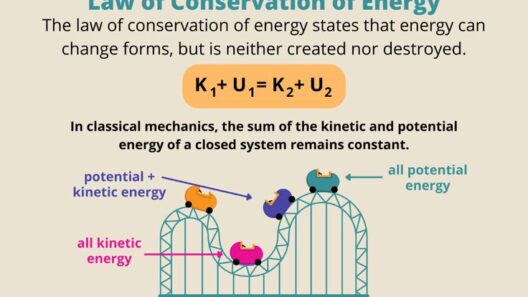Energy conservation is not merely a theoretical concept; it is a practical necessity that underpins our interaction with the physical world and supports our aspirations for a sustainable future. But have you ever wondered, “What if conserving energy became a sport? How would it be played?” This playful question sets the stage for a serious challenge: understanding how the principles of physics can be harnessed to conserve energy in practical, real-world applications. Let us explore this vital issue by dissecting the fundamental concepts of energy conservation, their implications for our daily lives, and innovative approaches to apply these principles effectively.
To tackle energy conservation, we must first comprehend the basic notions of energy itself. Energy exists in various forms—kinetic, potential, thermal, chemical, and nuclear, to name a few. Each type can be transformed from one form to another, but through every transformation, some energy is invariably lost as waste heat due to inefficiencies. This law of energy conservation states that energy cannot be created or destroyed, only transformed. Harnessing this understanding can lead to remarkable innovations in energy saving.
Consider kinetic energy, the energy of motion. Whether we are driving to the grocery store or cycling to work, our vehicles convert fuel into kinetic energy to propel us forward. However, do we really need large, gas-guzzling vehicles for these daily errands? Herein lies our challenge. By substituting a conventional car with a bicycle or an electric vehicle (EV), we considerably reduce fossil fuel consumption. Moreover, electric vehicles utilize regenerative braking—an ingenious system that captures kinetic energy produced during braking and converts it back into stored energy in the battery. Thus, both physics principles and modern technology converge to provide avenues for reducing energy usage.
Potential energy presents another rich arena for conservation efforts. This energy is stored in an object based on its position. For example, water stored in a high dam possesses substantial gravitational potential energy. Hydroelectric plants convert this stored potential energy into electricity, illustrating how nature’s laws can be utilized for sustainable energy. However, the construction of such dams often carries significant environmental and ecological costs. Thus, optimizing existing structures and employing low-impact hydropower solutions can be vital ways to harness potential energy without compromising environmental integrity.
Thermal energy, often a byproduct of energy conversion processes, is another major focus. Buildings can be significant sources of energy waste through inefficient heating and cooling systems. The principles of thermodynamics guide us to reconfigure how we think about thermal energy. For instance, using insulated windows, energy-efficient appliances, and programmable thermostats can help manage energy consumption more effectively. The adoption of passive solar design, which utilizes natural sunlight for heating and cooling, can further minimize reliance on artificial systems. This involves strategic orientation of structures and incorporation of thermal mass to store and distribute heat, ultimately embodying the essence of energy conservation.
The role of chemical energy should not be overlooked, particularly in the context of fossil fuels and renewable energy sources. Fossil fuels are formed from ancient biological matter, and their exploitation has led to climate degradation and environmental crises. Transitioning to renewable sources such as solar, wind, and biomass can significantly mitigate these adverse effects. Solar panels convert sunlight directly into energy, while wind turbines harness kinetic energy from the wind. Investing in renewable energy not only aligns with the principle of conserving energy but also reduces carbon footprints, thus combating climate change.
In pursuit of energy conservation, education plays an instrumental role. Understanding the physics behind energy consumption can empower individuals and communities to take proactive measures. Educating the public about energy-efficient practices, such as utilizing energy-efficient lighting, reducing water heating temperatures, and unplugging unused devices, can lead to substantial cumulative savings. Schools can incorporate energy conservation principles into their curricula, thus fostering a new generation that prioritizes sustainability.
Governments and organizations must also take the initiative to introduce policies that incentivize energy conservation. These can include tax rebates for energy-efficient home renovations, regulations on industrial energy consumption, and support for sustainable innovation. Public transportation systems must be enhanced to provide efficient alternatives to private vehicle use, showcasing collaborative efforts at community levels can amplify energy-saving practices.
One may argue that the transition to a world with lower energy consumption is fraught with challenges, but it is precisely these challenges that position us to rethink our relationship with energy. From individual actions to collective initiatives, the implementation of scientific concepts in real-world situations can lead to sustainable change. It is essential to view energy conservation not just as a necessity but as an opportunity for innovation and collaboration.
In conclusion, the concepts of energy conservation rooted in physics extend far beyond theoretical applications. They offer tangible solutions that can lead to a more sustainable future. By fostering a culture of energy awareness, promoting renewable technologies, and implementing efficient practices in our homes and industries, we can revolutionize our approach to energy. The playful question posed earlier remains pertinent: what if energy conservation were treated as a priority in our lives? By embracing this challenge, we can pave the way for a cleaner, more sustainable planet.








